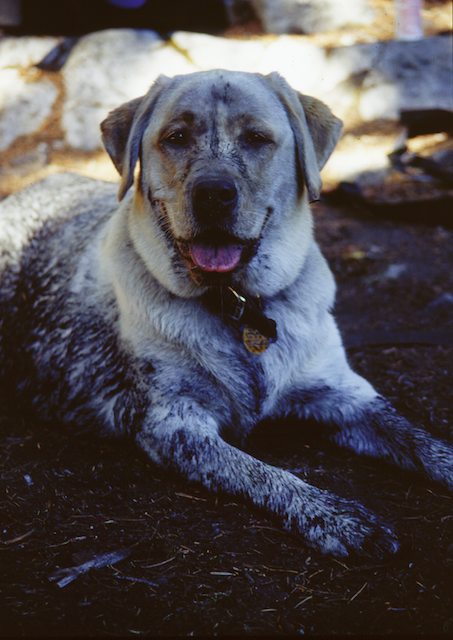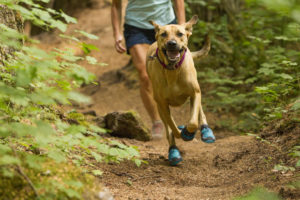My best friend, once and forever
We had too little time together
but she lived her life to the fullest
despite the handicaps she faced.
She no longer hikes by my side,
yet she is with me still on every journey.

Few things match the pleasure of walking a mountain trail with your best friend. Especially when that best friend is a sweet-natured, happy dog like Parka.
Since 1998, Parka has been my constant trail companion, joining me (and Donna) on nearly every hike – except of course the days we spent in National Parks, where dogs are banned. With Parka as my inspiration, I launched The Mountaineers Books’ “Best Hikes with Dogs” series, and she assisted with all the field research on our own work, the original “Best Hikes with Dogs: Western Washington” – which was also the inaugural book in the national series. With that book selling well, Parka went on to work as a model, selling a variety of dog products (from shampoos to canine packs, to Therma-Rest dog beds) in catalogs like Early Winters, LL Bean, and EMS.
For all her hard work as a trail-loving dog, though, Parka’s hiking life nearly ended before it got started. Just after turning 6 months old, Parka developed a limp. Our first vet – a specialist in hunting dogs and field trial champions – noted she had a genetic defect that left her with loose flaps of cartilage in her elbow joints. His recommendation: put her down and get a healthier pup.
Before we could say, “you’re fired,” we had a consultation with a new vet and a referral to a nationally acclaimed surgeon. That surgeon, Dr. Randy Ackers of Sun Valley Animal Center performed orthopedic surgery to remove that defective cartilage in both front legs. He noted the joints would never perform at 100 percent, but that she should have a good, active life. Unfortunately, a few months later, we were back in Sun Valley having her rear legs treated for the dog equivalent of ACL tears – both tibias were misaligned with her femurs, leaving her with stressed knees. The cure: saw off the tops of the tibias, reposition them, and bolt them back into place (known as Tibial Plateau Leveling).
So, before she was two years old, Parka had all four legs surgically repaired. Fortunately, her modeling career was doing well, and she paid for all that work herself! Even more importantly, the surgery was wildly successful. Within 9 months of the last surgery, Parka was powering up trails, and soon after was enjoying 20-mile hikes and long, multi-day backpacking trips. Donna and I monitored her constantly, knowing that she was susceptible to injury and chronic arthritis in those weakened joints. While we kept an eye on her stride, though, we enjoyed hundreds of days on the trail with our best friend.
Last winter, though, the day we feared came to pass. Parka’s persistent slight limp turned into a painful three-legged trudge. The thin band of scar cartilage that formed in her elbows was gone, worn to nothing. Those elbows now rubbed bone-on-bone and her right elbow was a mass of bone spurs and torn tissue. Once a proud hiker capable of enjoying 20-mile days, she now struggled to get around the backyard on her own. Our constant trail companion was now a couch potato. She whined when she saw us carry our packs out the door, wanting to go with us. But she cried more when she tried to run to the vehicle to go with us. I could tolerate her whines of being left behind, but only because her cries of pain seared my soul.
At just 10 years old, Parka became a retired hiker, fated to living her remaining days indoors. She probably should have stopped hiking a season (or two) earlier to minimize the damage of those degrading joints. If we had shut down her hiking career earlier, she would have been miserable the last year or two, but she might have had less physical pain to deal with at the end.
Of course, that’s the dilemma all of us face: do we let our dogs (and for that matter, ourselves) go on enjoying the trail life as long as possible, even though it could mean a shorter life and more pain in the final days. Or do we retire them (and ourselves) early, giving more time at the end of life, but far less joy? Parka’s greatest joy in life was going where Donna and I go, doing what we do. She suffered pain in her legs at the end, but if we had kenneled her while we hiked, she would have suffered intolerable sorrow over those years. I had to make the decision for her, but I think she would agree: the quality of life enjoyed was far more important than having a few more months of restricted living down the road.
The life of an aging dog is in the hands of their owner, and each owner must do what’s best for their companion. For a decade, Parka was my constant companion, my devoted hiking partner, and my very best friend. My dog, my friend, gave me her unconditional love and devotion. I tried to return that in full.
On a bleak, cold day in October, I gave her freedom from the pain that besieged her. It was the hardest thing I’ve ever done, but I could do no less. I loved her and continue to hold her in my heart. She was my best friend, once and forever.
* * *
Special thanks to Dr. Cara Borre and the staff of Sumner Animal Hospital. Dr. Borre provided wonderful care for Parka throughout the years. She effectively gave us the last year with our friend by holding Parka’s crippling pain at bay for as long as possible.
